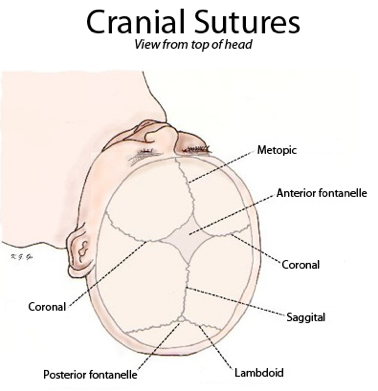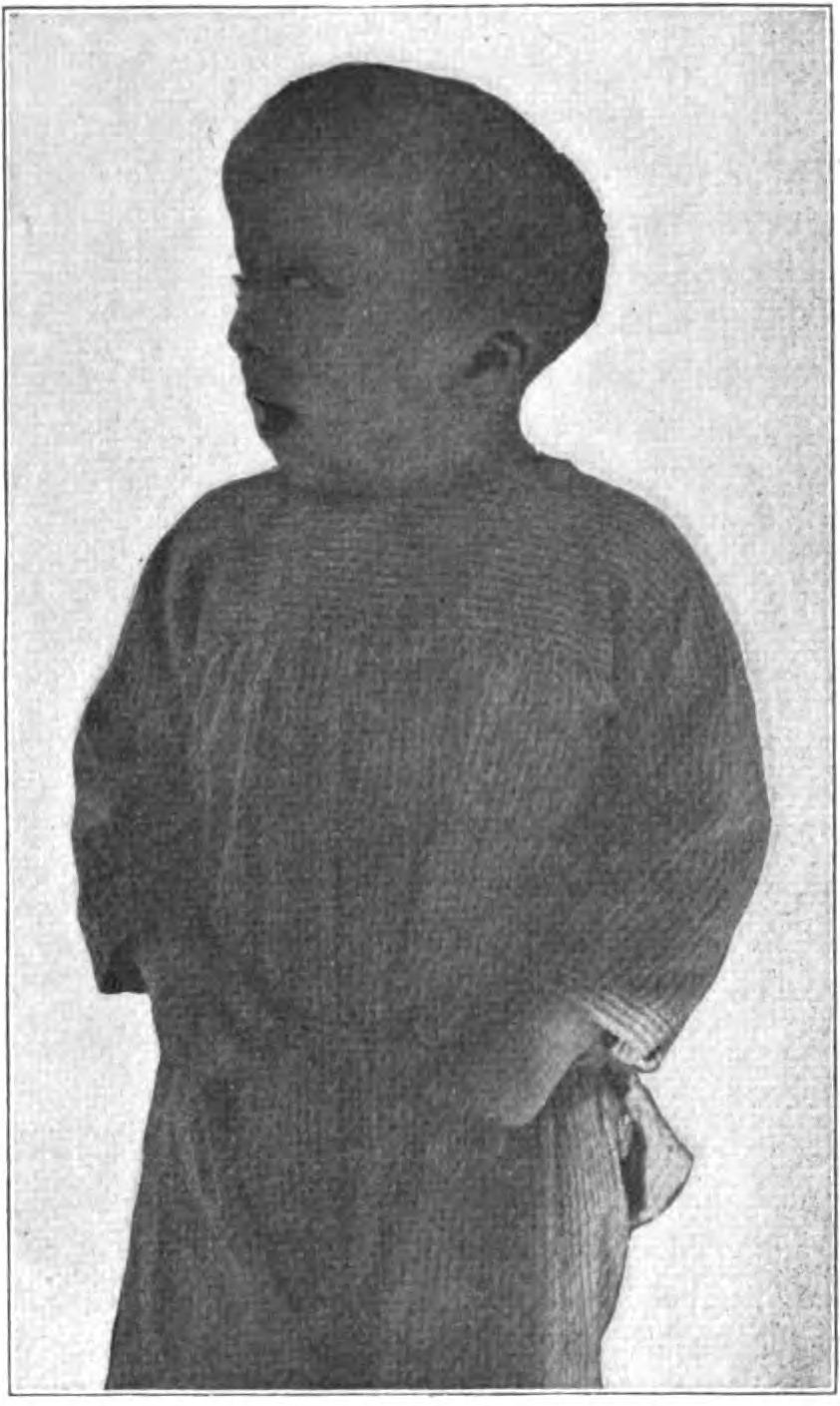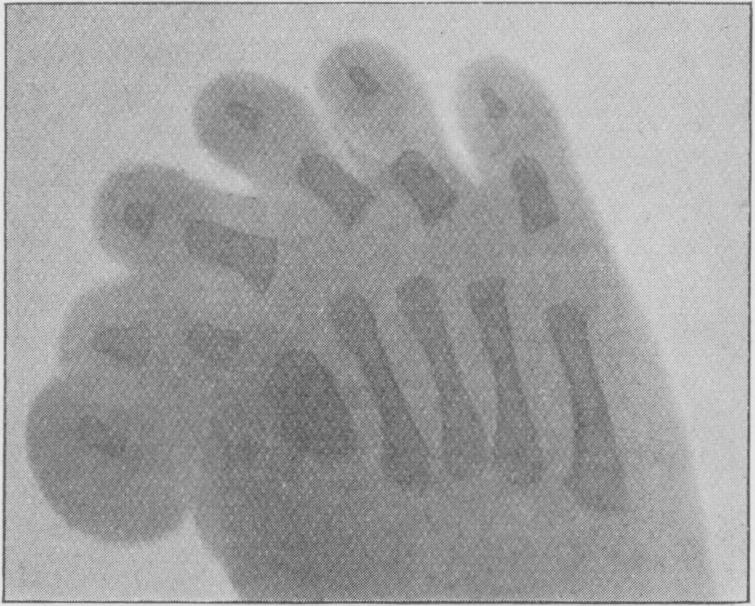|
Kleeblattschaedel
Kleeblattschaedel, or isolated cloverleaf skull syndrome, is a rare malformation of the head where there is a protrusion of the skull and broadening of the face. This condition is a severe type of craniosynostosis. The condition can be both isolated or associated with other craniofacial dysostosises. 85% of children with this condition have other anomalies. Severe forms of the condition are often a sign of syndromic craniosynostosis combined with a grotesque constriction ring of the lambdoid structure and the squamosal bone or in another area. Name and etymology ''Kleeblattschaedel'' (''Kleeblattschädel'') is German for "cloverleaf skull". The disorder was named Kleeblattschaedel syndrome in 1958. The German word is sometimes used in medical English, where it is often regarded as more or less naturalized, thus appearing in any combination of capitalized or not, with umlaut diacritic or not, and italicized or not. History The first case reported was in 1849. The condition was ... [...More Info...] [...Related Items...] OR: [Wikipedia] [Google] [Baidu] |
Proptosis
Exophthalmos (also called exophthalmus, exophthalmia, proptosis, or exorbitism) is a bulging of the eye anteriorly out of the orbit. Exophthalmos can be either bilateral (as is often seen in Graves' disease) or unilateral (as is often seen in an orbital tumor). Complete or partial dislocation from the orbit is also possible from trauma or swelling of surrounding tissue resulting from trauma. Exophthalmos has endocrine causes. In the case of Graves' disease, the displacement of the eye results from abnormal connective tissue deposition in the orbit and extraocular muscles, which can be visualized by CT or MRI. If left untreated, exophthalmos can cause the eyelids to fail to close during sleep, leading to corneal dryness and damage. Another possible complication is a form of redness or irritation called superior limbic keratoconjunctivitis, in which the area above the cornea becomes inflamed as a result of increased friction when blinking. The process that is causing the disp ... [...More Info...] [...Related Items...] OR: [Wikipedia] [Google] [Baidu] |
Thanatophoric Dysplasia
Thanatophoric dysplasia is a severe skeleton, skeletal disorder characterized by a disproportionately small Rib cage, ribcage, extremely short limbs and folds of extra skin on the arms and legs. Symptoms and signs Infants with this condition have disproportionately short arms and legs with extra folds of skin. Other signs of the disorder include a narrow chest, small ribs, underdeveloped lungs, and an enlarged head with a large forehead and prominent, wide-spaced eyes. Thanatophoric dysplasia is a lethal skeletal dysplasia divided into two subtypes. Type I is characterized by extreme rhizomelia, bowed long bones, narrow thorax, a relatively large head, normal trunk length and absent Kleeblattschaedel, cloverleaf skull. The spine shows platyspondyly, the cranium has a short base, and, frequently, the foramen magnum is decreased in size. The forehead is prominent, and hypertelorism and a saddle nose may be present. Hands and feet are normal, but fingers are short. Type II is charact ... [...More Info...] [...Related Items...] OR: [Wikipedia] [Google] [Baidu] |
Pfeiffer Syndrome
Pfeiffer syndrome is a rare genetic disorder, characterized by the premature fusion of certain bones of the human skull, skull (craniosynostosis), which affects the shape of the head and face. The syndrome includes abnormalities of the hands and feet, such as wide and deviated thumbs and big toes. Pfeiffer syndrome is caused by mutations in the fibroblast growth factor receptors ''FGFR1'' and ''FGFR2''. The syndrome is grouped into three types: type 1 (classic Pfeiffer syndrome) is milder and caused by mutations in either gene; types 2 and 3 are more severe, often leading to death in infancy, caused by mutations in ''FGFR2''. There is no cure for the syndrome. Treatment is supportive and often involves surgery in the earliest years of life to correct skull deformities and respiratory function. Most persons with Pfeiffer syndrome type 1 have a normal intelligence and life span; types 2 and 3 typically cause neurodevelopmental disorders and early death. Later in life, surgery c ... [...More Info...] [...Related Items...] OR: [Wikipedia] [Google] [Baidu] |
Antley–Bixler Syndrome
Antley–Bixler syndrome is a rare, severe autosomal recessive congenital disorder characterized by malformations and deformities affecting the majority of the skeleton and other areas of the body. Presentation Antley–Bixler syndrome presents itself at birth or prenatally. Features of the disorder include brachycephaly (flat forehead), craniosynostosis (complete skull-joint closure) of both coronal and lambdoid sutures, facial hypoplasia (underdevelopment); bowed ulna (forearm bone) and femur (thigh bone), synostosis of the radius (forearm bone), humerus (upper arm bone) and trapezoid (hand bone); camptodactyly (fused interphalangeal joints in the fingers), thin ilial wings (outer pelvic plate) and renal malformations. Other symptoms, such as cardiac malformations, proptotic exophthalmos (bulging eyes), arachnodactyly (spider-like fingers) as well as nasal, anal and vaginal atresia (occlusion) have been reported. Pathophysiology There are two distinct genetic mutation ... [...More Info...] [...Related Items...] OR: [Wikipedia] [Google] [Baidu] |
Congenital Disorders Of Musculoskeletal System
A birth defect is an abnormal condition that is present at birth, regardless of its cause. Birth defects may result in disabilities that may be physical, intellectual, or developmental. The disabilities can range from mild to severe. Birth defects are divided into two main types: structural disorders in which problems are seen with the shape of a body part and functional disorders in which problems exist with how a body part works. Functional disorders include metabolic and degenerative disorders. Some birth defects include both structural and functional disorders. Birth defects may result from genetic or chromosomal disorders, exposure to certain medications or chemicals, or certain infections during pregnancy. Risk factors include folate deficiency, drinking alcohol or smoking during pregnancy, poorly controlled diabetes, and a mother over the age of 35 years old. Many birth defects are believed to involve multiple factors. Birth defects may be visible at birth or diagn ... [...More Info...] [...Related Items...] OR: [Wikipedia] [Google] [Baidu] |
Muenke Syndrome
Muenke syndrome, also known as FGFR3-related craniosynostosis, is a human specific condition characterized by the premature closure of certain bones of the skull during development, which affects the shape of the head and face. First described by Maximilian Muenke, the syndrome occurs in about 1 in 30,000 newborns. This condition accounts for an estimated 8 percent of all cases of craniosynostosis. Signs and symptoms Many people with this disorder have a premature fusion of skull bones along the coronal suture. Not every case has had craniosynostosis however. Other parts of the skull may be malformed as well. This will usually cause an abnormally shaped head, wide-set eyes, low set ears and flattened cheekbones in these patients. About 5 percent of affected individuals have an enlarged head (macrocephaly). There may also be associated hearing loss in 10–33% of cases and it is important for affected individuals to have hearing tests to check on the possibility of a problem. They ca ... [...More Info...] [...Related Items...] OR: [Wikipedia] [Google] [Baidu] |
Crouzon Syndrome
Crouzon syndrome is an autosomal dominant genetic disorder known as a branchial arch syndrome. Specifically, this syndrome affects the first branchial (or pharyngeal) arch, which is the precursor of the maxilla and mandible. Because the branchial arches are important developmental features in a growing embryo, disturbances in their development create lasting and widespread effects. The syndrome is caused by a mutation in a gene on chromosome 10 that controls the body's production of fibroblast growth factor receptor 2 (''FGFR2''). Crouzon syndrome is named for Octave Crouzon, a French physician who first described this disorder. First called "craniofacial dysostosis" ("craniofacial" refers to the skull and face, and " dysostosis" refers to malformation of bone), the disorder was characterized by a number of clinical features which can be described by the rudimentary meanings of its former name. The developing fetus's skull and facial bones fuse early or are unable to expand. Thu ... [...More Info...] [...Related Items...] OR: [Wikipedia] [Google] [Baidu] |
Sensenbrenner Syndrome
Sensenbrenner syndrome (OMIM #218330) is a rare (less than 20 cases reported by 2010) multisystem disease first described by Judith A. Sensenbrenner in 1975. It is inherited in an autosomal recessive fashion, and a number of genes appear to be responsible. Three genes responsible have been identified: intraflagellar transport (IFT)122 (WDR10), IFT43—a subunit of the IFT complex A machinery of primary cilia, and WDR35 (IFT121: TULP4) It is also known as Sensenbrenner–Dorst–Owens syndrome, Levin syndrome I and cranioectodermal dysplasia (CED) Presentation These are pleomorphic and include * dolichocephaly (with or without sagittal suture synostosis) * microcephaly * pre- and postnatal growth retardation * brachydactyly * narrow thorax * rhizomelic dwarfism * epicanthal folds * hypodontia and/or microdontia * sparse, slow-growing, hyperpigmented, fine hair * nail dysplasia * hypohydrosis * chronic kidney failure * heart defects * liver fibrosis * visual deficits * photop ... [...More Info...] [...Related Items...] OR: [Wikipedia] [Google] [Baidu] |
Carpenter Syndrome
Carpenter syndrome, also called acrocephalopolysyndactyly type II, is an extremely rare autosome, autosomal dominance (genetics), recessive congenital disorder characterized by craniofacial surgery, craniofacial malformations, obesity, syndactyly, and polydactyly. Acrocephalopolysyndactyly is a variation of acrocephalosyndactyly that presents with polydactyly. It was first characterized in 1909, and is named for George Alfred Carpenter. Presentation Carpenter syndrome presents several features: * Turricephaly – tower-shaped skull * Polydactyly – additional digits (fingers and toes) * Syndactyly – fused digits * Obesity * Reduced height * Undescended testes (in males) Intellectual disability is also common with the disorder, although some patients may have average intellectual capacity. Description Carpenter syndrome belongs to a rare genetic disorder known as acrocephalosyndactyly, (ACPS) (RN, 2007). There were originally five types of ACPS, but this number has been d ... [...More Info...] [...Related Items...] OR: [Wikipedia] [Google] [Baidu] |
Beare–Stevenson Cutis Gyrata Syndrome
Beare–Stevenson cutis gyrata syndrome is a rare genetic disorder characterized by craniosynostosis (premature fusion of certain bones of the skull, sometimes resulting in a characteristic 'cloverleaf skull'; further growth of the skull is prevented, and therefore the shape of the head and face is abnormal) and a specific skin abnormality, called cutis gyrata, characterized by a furrowed and wrinkled appearance (particularly in the face and on the palms and soles of the feet); thick, dark, velvety areas of skin (acanthosis nigricans) are sometimes found on the hands and feet and in the groin.http://ghr.nlm.nih.gov/condition/beare-stevenson-cutis-gyrata-syndrome The Genetic Home Reference entry on Beare-Stevenson cutis gyrata syndrome Presentation Signs and symptoms of Beare–Stevenson cutis gyrata syndrome can include a blockage of the nasal passages (choanal atresia), overgrowth of the umbilical stump, and abnormalities of the genitalia and anus. The medical complications associ ... [...More Info...] [...Related Items...] OR: [Wikipedia] [Google] [Baidu] |
Coronal Suture
The coronal suture is a dense, fibrous connective tissue joint that separates the two parietal bones from the frontal bone of the skull. Structure The coronal suture lies between the paired parietal bones and the frontal bone of the skull. It runs from the pterion on each side. Nerve supply The coronal suture is likely supplied by a branch of the trigeminal nerve. Development The coronal suture is derived from the paraxial mesoderm. Clinical significance If certain bones of the skull grow too fast then premature fusion of the sutures, craniosynostosis, may occur. This can result in skull deformities. These deformities include: * Brachycephaly (both sides) * Plagiocephaly (one side only) * Oxycephaly (both sides) References * "Sagittal suture." ''Stedman's Medical Dictionary, 27th ed.'' (2000). * Moore, Keith L., and T.V.N. Persaud. ''The Developing Human: Clinically Oriented Embryology, 7th ed.'' (2003). Additional images File:Coronal suture - ani ... [...More Info...] [...Related Items...] OR: [Wikipedia] [Google] [Baidu] |
Recurrent Corneal Erosion
Recurrent corneal erosion (RCE) is a disorder of the eyes characterized by the failure of the cornea's outermost layer of epithelial cells to attach to the underlying basement membrane ( Bowman's layer). The condition is excruciatingly painful because the loss of these cells results in the exposure of sensitive corneal nerves. This condition can often leave patients with temporary blindness due to extreme light sensitivity (photophobia). Signs and symptoms Symptoms include recurring attacks of severe acute ocular pain, foreign-body sensation, photophobia (i.e. sensitivity to bright lights), and tearing often at the time of awakening or during sleep when the eyelids are rubbed or opened. Signs of the condition include corneal abrasion or localized roughening of the corneal epithelium, sometimes with map-like lines, epithelial dots or microcysts, or fingerprint patterns. An epithelial defect may be present, usually in the inferior interpalpebral zone. Cause Most cases of recurrent ... [...More Info...] [...Related Items...] OR: [Wikipedia] [Google] [Baidu] |



